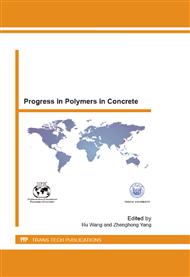[1]
Y. Ohama, Handbook of Polymer-Modified Concrete and Mortars Properties and Process Technology. Noyes Publication, New Jersey, 1995.
Google Scholar
[2]
Z. Su, J.M.J.M. Bijen, A.L.A. Fraaij, Interaction of polymer dispersions with Portland cement paste. Materials Research Society Symposium Proceedings, 289(1993) 199-204.
DOI: 10.1557/proc-289-199
Google Scholar
[3]
M. Puterman, W. Malorny. Some doubts and ideas on the microstructure formation of PCC, in Sandrolini F (ed.), Proceedings of IX International Congress on Polymers in Concrete, Bologna, 1998, pp.166-178.
Google Scholar
[4]
A. Dimmig, Direkte und indirekte Einflussnahme von Kunststoffmodifizierungen auf die Eigenschaften, insbensondere auf die Dauerhaftigkeit von Mörteln. Proceedings of the 15th Internationale Baustofftagung (Tagungsbericht),Weimar, Germany, 2003, Bd. 2, pp.2-331–2-346.
Google Scholar
[5]
S. Zhong, C. Zhang, Z. Zhang, and Z. Chen, Study on Absorption of Polymer on Cement in Fresh Paste, Proceedings of the 12th International Congress on Polymers in Concrete, Chuncheon, Korea, 2007,Volume I, pp.92-100.
Google Scholar
[6]
J. Plank, M. Gretz, Study on the interaction between anionic and cationic latex particles and Portland cement, Colloids and Surfaces A: Physicochem. Eng. Aspects 330 (2008) 227–233.
DOI: 10.1016/j.colsurfa.2008.08.005
Google Scholar
[7]
D. Han, J. Li, K. Ni and S. Zhong, Influence of Cellulose Ether on Separation of Latex Modified Cement Paste by still standing test, Proceedings of 7th Asian Symposium on Polymers in Concrete, Istanbul, Turkey, 2010, pp.175-182
Google Scholar
[8]
L. Ferrari, J. Kaufmann, F. Winnefeld, J. Plank, Interaction of cement model systems with superplasticizers investigated by atomic force microscopy, zeta potential, and adsorption measurements, Journal of Colloid and Interface Science 347 (2010) 15–24.
DOI: 10.1016/j.jcis.2010.03.005
Google Scholar
[9]
A. Zingg, F. Winnefeld, L. Holzer, J. Pakusch, S. Becker, R. Figi, L. Gauckler, Interaction of polycarboxylate-based superplasticizers with cements containing different C3A amounts, Cement & Concrete Composites 31 (2009) 153–162.
DOI: 10.1016/j.cemconcomp.2009.01.005
Google Scholar
[10]
J. Lu, J. Liu, Y. Shang, et al, Effect of property of the cement paste by adding polycarboxylate superplasticizer, Concrete, 37 (2009) 1153-1159 (in Chinese).
Google Scholar
[11]
D.A. Silva, P.J.M. Monteiro, Hydration evolution of C3S–EVA composites analyzed by soft X-ray microscopy, Cement and Concrete Research 35 (2005) 351–357.
DOI: 10.1016/j.cemconres.2004.05.049
Google Scholar
[12]
A. Dimmig-Osburg, Microstructure of PCC–Effects of Polymer Components and Additives, 12th International Congress on Polymers in Concrete, Chuncheon, Korea, 2007, pp.239-248.
Google Scholar
[13]
E. Sakai, R. Okudaira, T. Sugiyama, M. Daimon, Adsorption of Polymer Particles on Cement in Polymer Modified cement, 12th International Congress on Polymers in Concrete, Chuncheon, Korea, 2007, pp.233-23
Google Scholar


